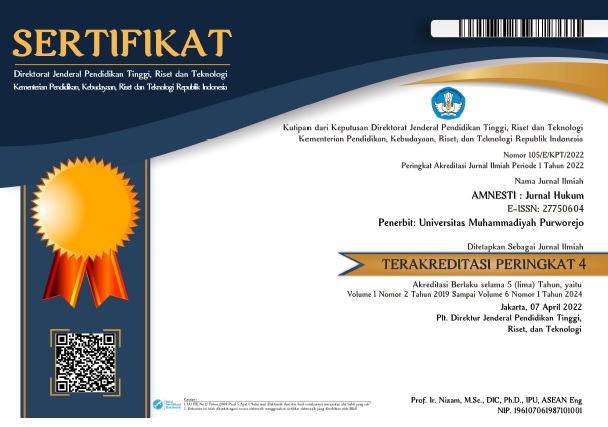Chemical Weapons Violations in Syria's Civil War: an International Law Perspective
Abstract
The use of chemical weapons in the Syrian civil war is a grave violation of international law, as it violates the prohibition on using chemical weapons under customary international law. The war has erupted since Syrian President Bashar Al-Assad responded violently to the peaceful opposition toward the regime. The Organization for the Prohibition of Chemical Weapons (OPCW) has confirmed two occasions of using chemical weapons in Syria in 2015 and 2016. However, until recently, there were no necessary measures to protect civilians in Syria from using chemical weapons and prevent any future use of Syria's stockpile of chemical weapons. The study aims to analyze the use of chemical weapons in the Syrian civil war, the violation of the CWC in the Syrian civil war, and the legal protection of Syrian civilians. The study used a normative legal research methodology. The data sources in the study were secondary data obtained from the statutory, analytical, legal, conceptual, and fact approaches. The study's result showed that the Syrian government violated the Chemical Weapons Convention of 1993 (CWC) and should respond with the action, categorized as an infringement of the international legal norm.
Downloads
References
Anderson, T. (2016). The Dirty War On Syria: Chemical Fabrications, The East Ghouta Incident. December 2015, 1–11.
Brooks, J., Erickson, T. B., Kayden, S., Ruiz, R., Wilkinson, S., & Burkle, F. M. (2018). Responding to Chemical Weapons Violations in Syria: Legal, Health, and Humanitarian Recommendations. Conflict and Health, 12(1), 1–7. https://doi.org/10.1186/s13031-018-0143-3
Bunker, R. J. (2018). Strategic Insights : The Assad Regime and Chemical Weapons.
Chin, J., Song, W., & Wright, J. (2022). Personalization of Power and Mass Uprisings in Dictatorships. British Journal of Political Science, 1–20. https://doi.org/10.1017/S0007123422000114
Geiger, D. (2017). How Chlorine Gas Became a Weapon in Syria’s Civil War. Www.Aljazeera.Com. https://www.aljazeera.com/features/2017/3/23/how-chlorine-gas-became-a-weapon-in-syrias-civil-war
Gunter, M. M. (2014). Out of Nnowhere: The Kurds of Syria in Peace and War. Oxford University Press Inc.
Koplow, D. A. (2012). Train Wreck : The U.S. Violation of the Chemical Weapons Convention. Journal of National Security Law & Policy, 6(319), 325.
Moradi, F., Söderberg, M., Moradi, F., Daka, B., Olin, A. C., & Lärstad, M. (2019). Health Perspectives Among Halabja’s Civilian Survivors of Sulfur Mustard Exposure with Respiratory Symptoms—A Qualitative Study. PLoS ONE, 14(6), 1–16. https://doi.org/10.1371/journal.pone.0218648
Murphy, B. E. N. L. (2020). Situating the accountability of the un Security Council: Between liberal-legal and political “styles” of global constitutionalism? Global Constitutionalism, August 2017, 465–499. https://doi.org/10.1017/S2045381720000222
Nations, U. (2013). United Nations Mission to Investigate Allegations of the Use of Chemical Weapons in the Syrian Arab Republic.
Richard, D. A. E. (2014). Cold War Resurgence: The Case of Syrian Uprising. IOSR Journal of Humanities and Social Science, 19(8), 39–47. https://doi.org/10.9790/0837-19823947
Riyanto, S. (2013). Kajian tentang Pertautan Hukum Humaniter Internasional dengan Hukum Pengungsi. Media Hukum, 20(1), 30–45.
SAMS. (2016). A New Normal: Ongoing Chemical Weapons Attacks in Syria. Www.Sams-Usa.Net. https://www.sams-usa.net/reports/a-new-normal-ongoing-chemical-weapons-attacks-in-syria/
Schneider, T., & Lütkefend, T. (2019). Nowhere to Hide: The Logic of Chemical Weapons Use in Syria. Www.Gppi.Net. https://gppi.net/2019/02/17/the-logic-of-chemical-weapons-use-in-syria
Shesterinina, A., & Job, B. L. (2016). Particularized Protection: UNSC Mandates and the Protection of Civilians in Armed Conflict. International Peacekeeping, 23(2), 240–273. https://doi.org/10.1080/13533312.2015.1123628
Sihvo, O. (2014). Responsibility to Protect : Clarifying the Nature of State Obligations. Helsinki Law Review, 2(8), 255–291.
Sivakumaran, S. (2011). Re-envisaging the international law of internal armed conflict. European Journal of International Law, 22(1), 219–264. https://doi.org/10.1093/ejil/chq083
Soekanto, S., & Mamuji, S. (2006). Normative Legal Research. Raja Grafindo Persada.
SOHR. (2021). Total Death Toll | Over 606,000 People Killed Across Syria Since the Beginning of the “Syrian Revolution”, including 495,000 documented by SOHR. Www.Syriahr.Com.
Suryokumoro, H., & Ikaningtyas, I. (2020). Perlindungan Terhadap Penduduk Sipil Pada Saat Terjadi Konflik Bersenjata Berdasarkan Hukum Humaniter Internasional Dan Hukum Pertahanan Indonesia. Rechtidee, 15(2), 207–244. https://doi.org/10.21107/ri.v15i2.8576
Trapp, R. (2017). The Use of Chemical Weapons in Syria: Implications and Consequences. In B. Friedrich (Ed.), One Hundred Years of Chemical Warfare: Research, Deployment, Consequences (pp. 363–375). Springer Berlin Heidelberg.
Zanders, J. P. (1996). The CWC in the context of the 1925 Geneva debates. Nonproliferation Review, 3(3), 38–45. https://doi.org/10.1080/10736709608436636
Copyright (c) 2023 Amnesti: Jurnal Hukum

This work is licensed under a Creative Commons Attribution-NonCommercial 4.0 International License.






